- SBUX has declined almost 18% YTD
- Shares have beaten EPS expectations for the past 5 quarters
- The Wall Street consensus outlook is bullish
- The market-implied outlook (derived from options prices) is also bullish
Starbucks (NASDAQ:SBUX) has had quite a year and is now below the share price from one year ago. The YTD and 12-month total returns for SBUX are -17.7% and -6.2%, respectively. Even with the recent price declines, SBUX has a P/E of 27.
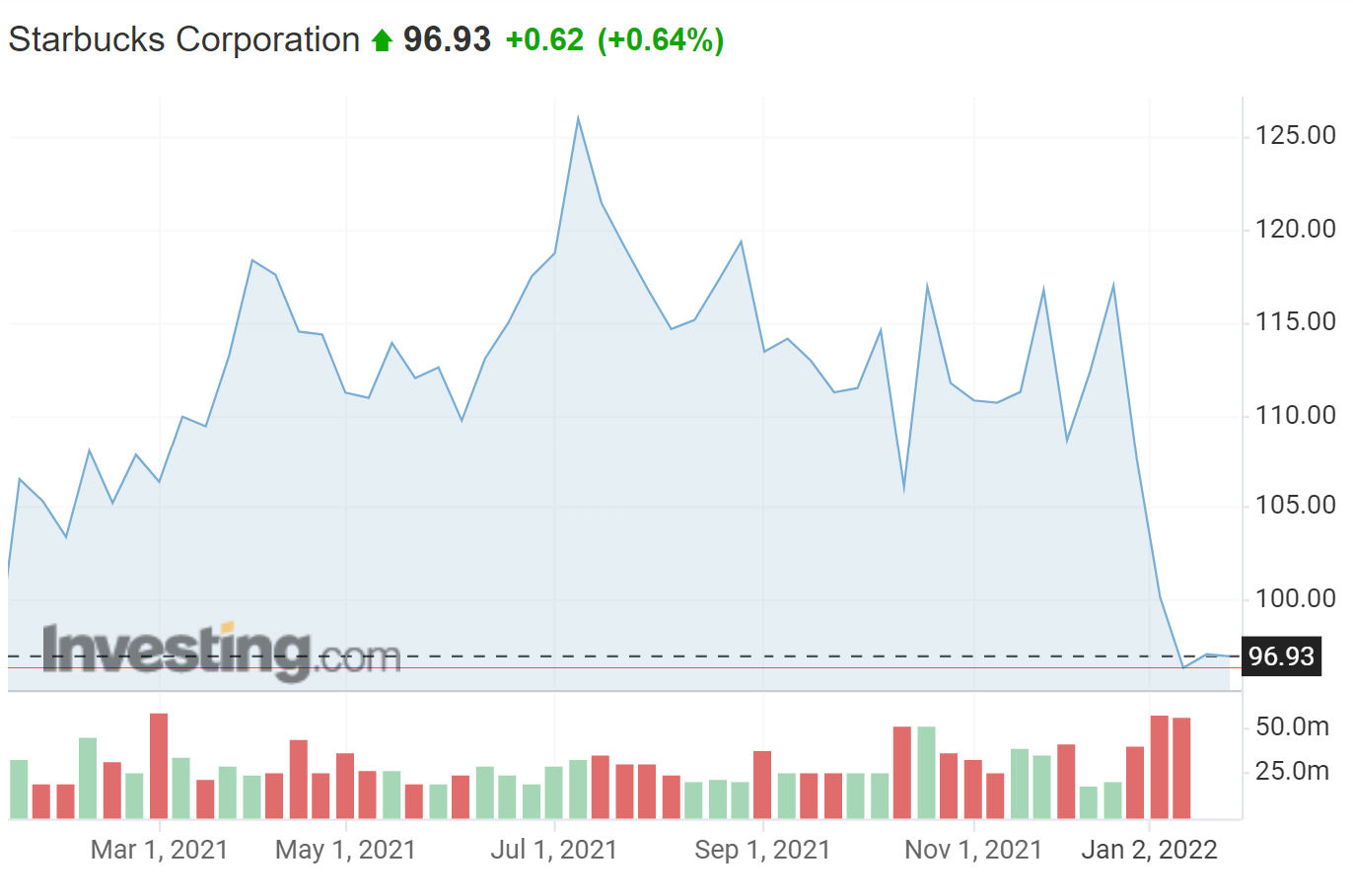
Source: Investing.com
SBUX faces two significant headwinds, along with the general challenges restaurants are experiencing (inflation, supply-chain constraints, rising wages).
The first is the increasing traction of labor unions and the company’s efforts to dissuade workers from joining unions. The second is maintaining growth in China in the face of growing competition from Chinese firms. With 5,000 Starbucks locations, China is the company’s largest market outside of the US and represents the highest potential growth opportunities.
SBUX has delivered consistently strong earnings as the economy recovered from the COVID-driven shutdowns of 2020. Its quarterly EPS have beaten the consensus expected levels for the past five quarters. The consensus for FY Q1, to be reported on Feb. 1, is for an EPS of $0.80.

Source: E-Trade. Green (red) values are the amount by which quarterly EPS exceeded (missed) the consensus expected value.
I last analyzed SBUX in October, when the shares had fallen 12% from the YTD high close. The Wall Street analyst consensus rating for SBUX was bullish and the consensus 12-month price target was more than 17% above the share price at that time. The valuation for SBUX was quite high, with a P/E of 34, but the growth outlook was also strong.
Along with the fundamentals and the Wall Street consensus outlook, I rely on the options market when analyzing stocks. The price of an option on a stock reflects the market’s consensus estimate of the probability that the stock price will rise above (call option) or fall below (put option) a specific level (the option strike price) between now and when the option expires.
By analyzing the prices of call and put options at a range of strike prices, all with the same expiration date, it is possible to calculate a probable price forecast that reconciles the options prices. This is called the market-implied outlook and represents the consensus view of buyers and sellers of options.
In October, the market-implied outlook for SBUX to early 2022 (calculated using options that expired on Jan. 21, 2022) was slightly bullish and the expected volatility was a modest 27% (annualized).
With bullish views from the Wall Street analyst consensus and the market-implied outlook, I gave SBUX a bullish rating overall. Since that article was published, SBUX has fallen 13%, as compared with a decline of 1.47% for the S&P 500. SBUX’s fall appears to be due to concerns about growth in China, the ongoing labor issues and the broad slump in growth stocks in response to rising interest rates.
I have updated the market-implied outlooks for SBUX using options that expire during 2022 and in January of 2023 and compared to the current Wall Street consensus outlook for SBUX.
Wall Street Consensus Outlook For SBUX
E-Trade calculates the Wall Street consensus by combining the views of 23 ranked analysts who have published ratings and price targets for SBUX over the past 90 days. The consensus rating is bullish and the consensus 12-month price target is 28.7% above the current price. The 12-month price target is down slightly from the value in October ($130.63). The consensus among the analysts is that the recent sell-off in the shares is unwarranted.
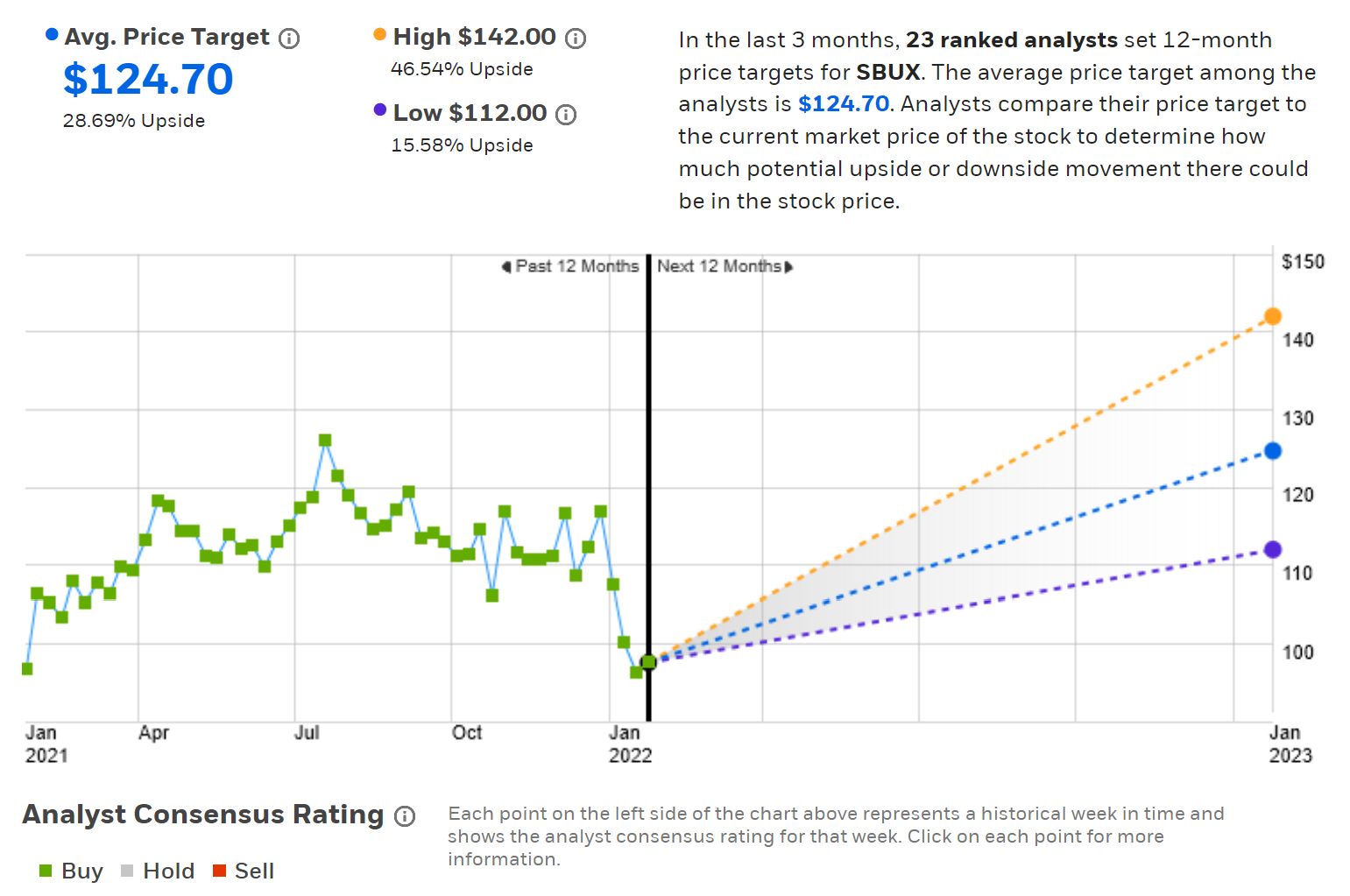
Source: E-Trade
Investing.com calculates the Wall Street consensus based on the views of 35 analysts. The consensus rating is bullish and the consensus 12-month price target is 26.9% above the current share price.
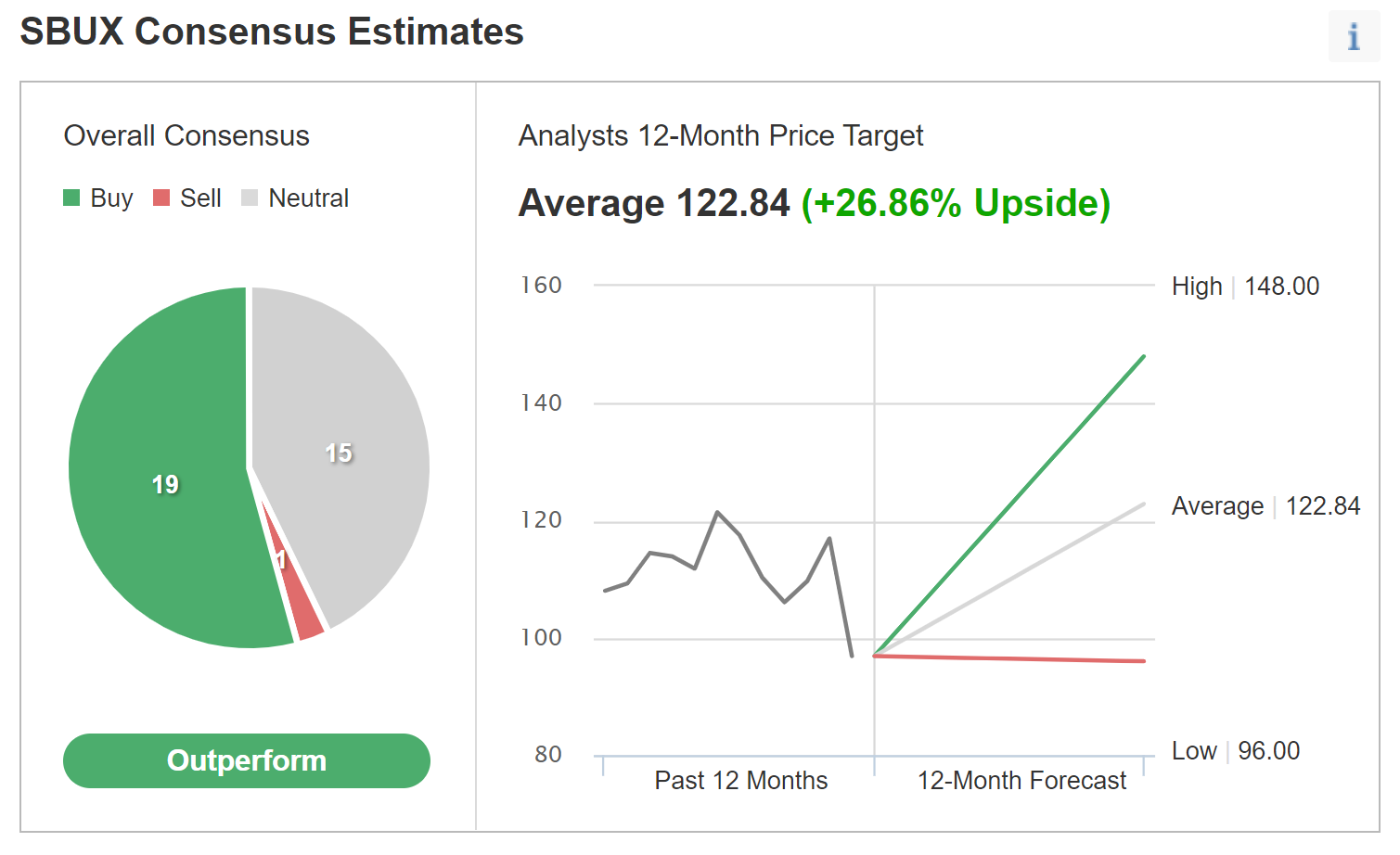
Source: Investing.com
These two versions of the Wall Street consensus agree, with a bullish rating for SBUX and a 12-month price target that is about 28% above the current share price.
Market-Implied Outlook For SBUX
I have calculated the market-implied outlooks for SBUX to the middle of 2022 (using options that expire on June 17, 2022) to early 2023 (using options that expire on Jan. 20, 2023). I selected these dates to provide views to the middle of 2022 and through the year.
The standard presentation of the market-implied outlook is in the form of a probability distribution of price returns, with probability on the vertical axis and return on the horizontal.
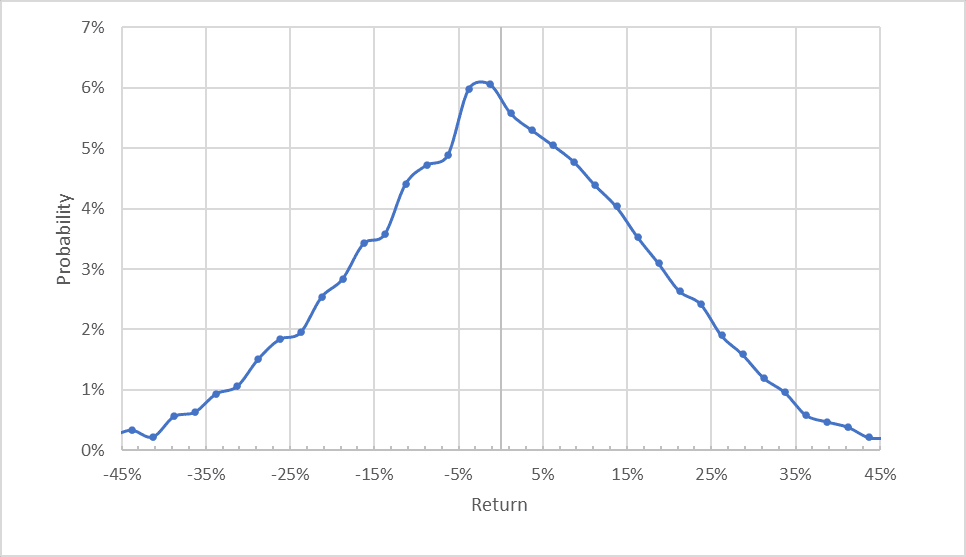
Source: Author’s calculations using options quotes from E-Trade
The market-implied outlook to June 17, 2022, is quite symmetric, with similar probabilities of positive and negative returns of the same magnitude. The peak in probability is slightly tilted to favor negative returns. The annualized volatility calculated from this distribution is 36.4%.
To make it easier to directly compare the probabilities of positive and negative returns, I rotate the negative return side of the distribution about the vertical axis (see chart below).
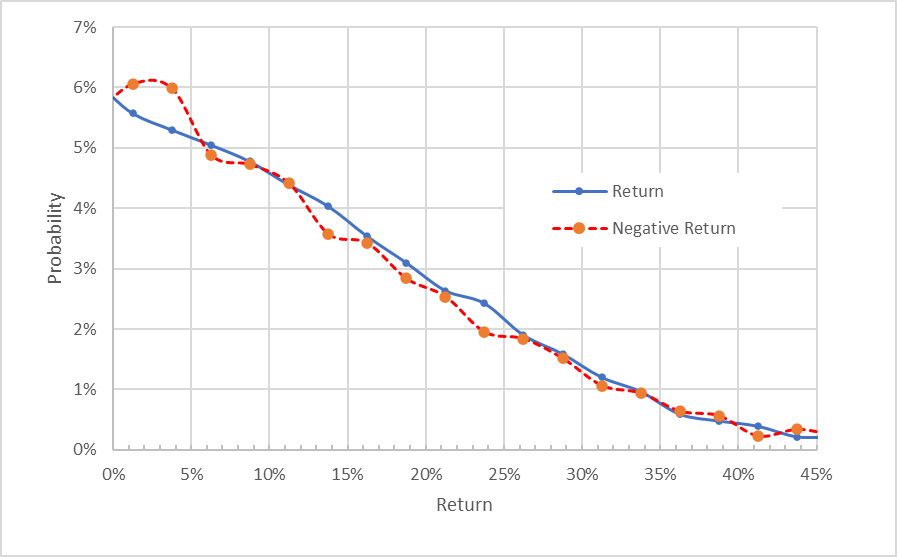 Source: Author’s calculations using options quotes from E-Trade. The negative return side of the distribution has been rotated about the vertical axis.
Source: Author’s calculations using options quotes from E-Trade. The negative return side of the distribution has been rotated about the vertical axis.
This view shows just how close the probabilities of positive and negative returns tend to be. The slightly-elevated probability of small-magnitude negative returns (the red dashed line is above the solid blue line on the far left of the chart) is not large enough to be considered meaningful. Theory suggests that the market-implied outlook will tend to be biased to favor negative returns because risk averse investors pay more than fair value for downside protection (put options). In light of this potential negative bias, this market-implied outlook is best interpreted as being slightly bullish.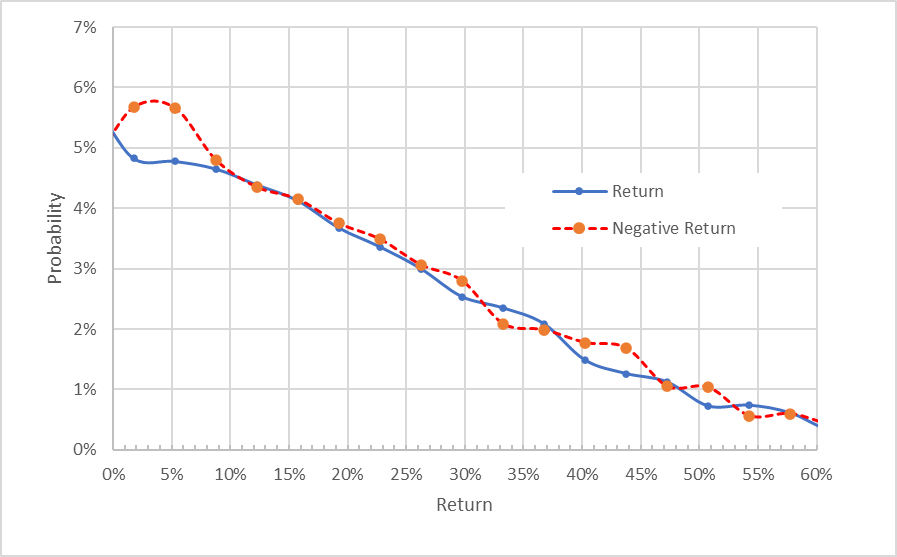
Source: Author’s calculations using options quotes from E-Trade. The negative return side of the distribution has been rotated about the vertical axis.
The market-implied outlook to Jan. 20, 2023 is consistent with the view to the middle of 2022. Aside from slightly-elevated probabilities of small-magnitude negative returns, the probabilities of positive and negative returns match very closely. The expected volatility calculated from this distribution is 33.1%.
Summary
Starbucks has underperformed over the past 12 months, largely due to the high growth expectations that were reflected in the share prices. The shares have declined more than the broader market, not least due to discounting of growth stock earnings as interest rates rise.
However, the longer-term narrative for SBUX, especially in China, continues to be compelling. While the company has opposed labor unions, the impact of collective bargaining is unclear.
The Wall Street consensus outlook continues to be bullish, with a 12-month price target that is around 28% higher than the current share price. The market-implied outlook is slightly bullish to mid-2022 and for the next 12 months, with higher volatility in the first half of the year. I am maintaining my overall bullish rating on SBUX.
